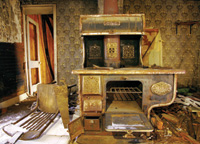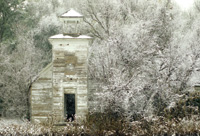Steve Gottliebs Abandoned America
Visual Clues From On The Road
Steve Gottlieb's photographs are bits of life that have vanished from our world forever--structures emptied of any signs of human existence, fragmented testimonials of our past. Gottlieb and I are sitting in my Boston studio looking through his latest book, Abandoned America. We come upon the photograph of an empty room, its peeling paint and partially demolished ceiling presenting a strange mélange of colors. He wonders aloud. "What could have made someone clear out everything? There's not a bedspring or faded newspaper, a broken doll or a half-eaten jar of peanut butter. It's as though someone attempted to expunge evidence of a crime." |
|||
In another image taken in a
remote and deserted reach of the Sierra Mountains in Bodie, California,
an outhouse leans precariously in the snow. It is a visual poem of intense
melancholy, the rich patina of the weathered wood contrasting with the
pristine and desolate wilderness. |
|||
The Impetus To Record |
|||
As Gottlieb explains in the
forward of Abandoned America, the magic moment is "a combination
of when the esthetics please me and when the subject seems to transport
me to another place, a historical place. Even though there are no people
there, like on the cover shot, I could sort of feel someone driving that
truck. |
|||
The Evolution Of His
Vision |
|||
"Hey, Do A Book..." |
|||
The subtle color in most of Gottlieb's photographs goes along with the feeling of things that are old. "There is a lot of color we don't see and we translate in our minds what we think we are seeing. We look at wood and see brown and don't see the bluish tint that is there. In one image of a coalmine shed it was the lush iridescent blue that attracted me and prompted me to photograph. Many people who look at my work think I am a master in Photoshop. Though I am not tied to the notion of capturing a scene just as it is, I am apt to workin Photoshop only to remove anything that is distracting or superfluous or to what I think destroys the essence of the picture." |
|||
Gear For The Road |
- Log in or register to post comments









































